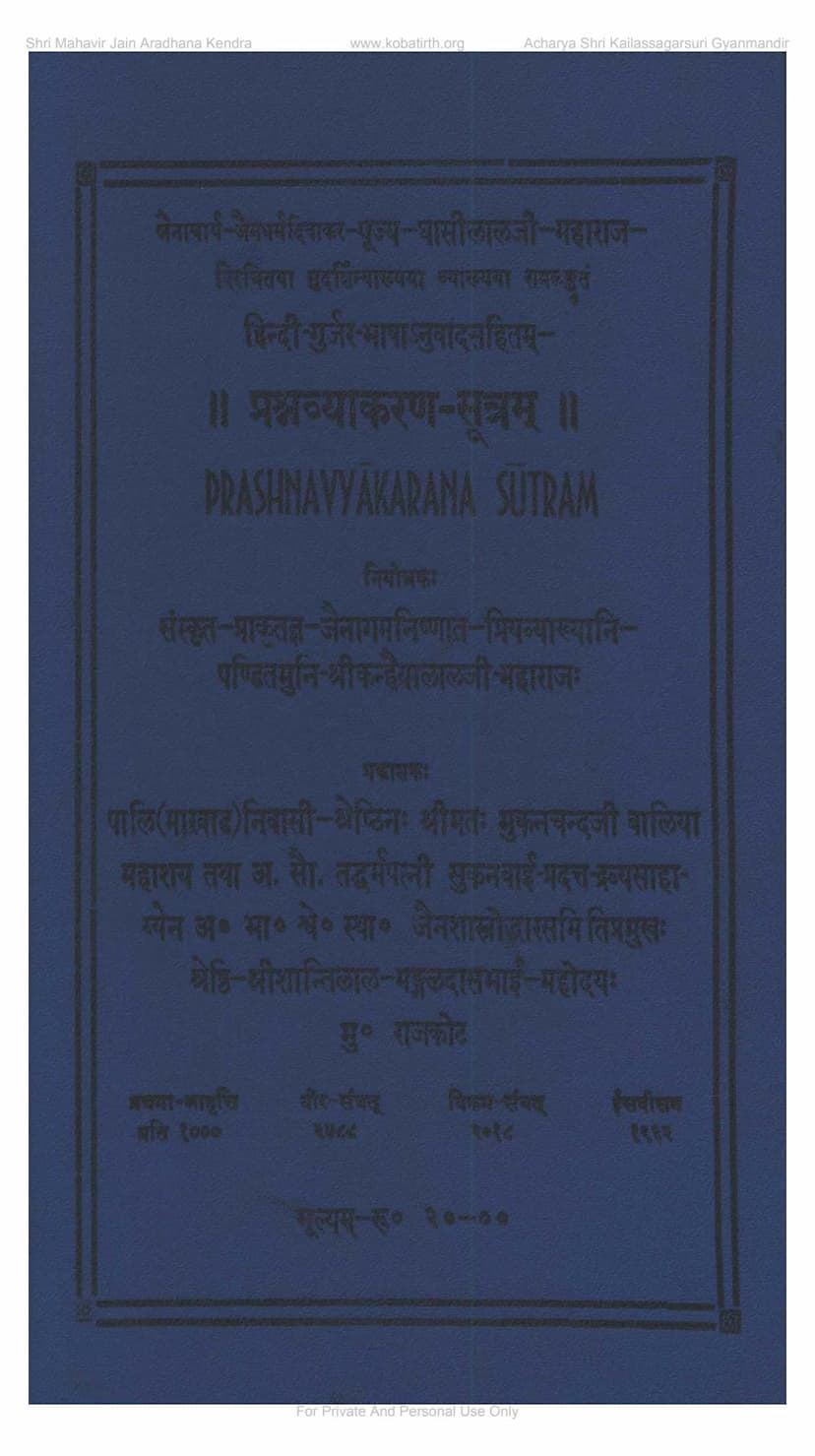Prashnavyakaran Sutram
Added to library: September 2, 2025

Summary
Here's a summary of the provided Jain text, "Prashnavyakaran Sutram," based on the provided pages:
Prashnavyakaran Sutram (Book of Questions and Answers)
This comprehensive Jain text, the "Prashnavyakaran Sutram," is a foundational scripture within Jainism, meticulously compiled and presented with extensive commentaries and translations. The provided pages highlight its structure, key themes, and the scholarly efforts behind its dissemination.
Author and Commentary: The primary text is attributed to the teachings of Lord Mahavir. The edition presented features a detailed commentary by Pandit Muni Shri Kanhaiyalalji Maharaj, renowned for his expertise in Sanskrit, Prakrit, Jain Agamas, and his insightful explanations. The text is also enriched by the commentary of Jainacharya Shri Ghasilalji Maharaj, further illuminating its profound meanings.
Publisher and Supporters: Published by the Shri Akhil Bharat Shwetamber Sthanakvasi Jain Shastroddhara Samiti, the work is a testament to their commitment to preserving and promoting Jain scriptures. Significant financial support was provided by Seth Mukundchandji Baliya (Palewala) of Ahmedabad, and his wife Smt. Sugankunwar Bai, along with numerous other patrons listed in the document, whose generosity made this publication possible. The publication date is noted as Veer Samvat 2488, Vikram Samvat 2018, and CE 1962.
Structure and Content Overview (Based on the Subject Index - Page 4 onwards): The "Prashnavyakaran Sutram" is structured into multiple studies (Adhyayans), each delving into specific aspects of Jain philosophy, ethics, and cosmology. The index reveals a systematic approach to understanding the path to spiritual liberation.
The First Part of the text focuses on the causes of worldly suffering and the means of overcoming them. It meticulously outlines:
- Causes of Karma (Asrava): Detailed discussions on various forms of Asrava, including:
- The nature of Asrava and Sanvar (influx and stoppage of karma).
- The "Adharma Dwar" (doors of unrighteousness/immorality) are explored through specific topics like:
- False speech (Mriduvada).
- The concept of "Yathakrut" (as it is).
- Classification of animals based on their sensory faculties (Chadurindriya, Trindriya, Dvindriya, Ekendriya).
- The causes and intentions behind harming various beings (earth-bodied, water-bodied, fire-bodied, air-bodied, plant-bodied).
- The types of violence and the motivations behind them.
- The consequences of sinful actions, including descriptions of hellish suffering, the torments faced by the inhabitants of hell, and their lamentations.
- The suffering of beings in the animal realm (Tiryanggati) and the specific pains experienced by creatures with different numbers of senses.
- General descriptions of suffering.
- Suffering in the human realm.
- The Five Great Vows (Pancha Anarthadanda/Ahiṃsā): The second part of the studies shifts to the path of liberation, focusing on the five great vows, particularly:
- Ahimsa (Non-violence): Its importance, the characteristics of great souls who practice it, their duties, and the five internal disciplines (Bhavana) related to Ahimsa: Iryasmiti (mindfulness in movement), Manogupti (control of mind), Vachansamiti (control of speech), Eshana Samiti (mindfulness in receiving alms), and Nikshapa (proper placement of objects).
- Satya (Truthfulness): Its nature and the disciplines associated with it: Anavachintya Samiti (contemplation without worry), control of anger, contentment, patience, and silence.
- Adattadan Viraman (Non-stealing): Its nature, how munis (ascetics) practice it, and the five disciplines related to it: Vivikta Vasati Vash (living in solitude), Anugyata Samtharak (accepting allowed bedding), Shaiyaparikarma Varjan (avoiding forbidden adornment of bedding), Anugyata Ahara (accepting permitted food), and Vinay (humility).
- Brahmacharya (Celibacy): Its nature, the fruits of practicing it, what is acceptable and unacceptable for Brahmacharis, and the five disciplines: Asansakta Vasavasati (living unaffiliated), Stri Katha Virati (abstaining from talks about women), Stri Roop Nirikshan Varjan (avoiding looking at women), Purata-Purva Kreeditadi Virati (abstaining from past enjoyments), and Madita Bhojan Varjan (avoiding delicious food).
- Parigraha Viraman (Non-possession): Its nature, the specific non-possession related to stationary beings, unattainable objects, and attainable food items, and the disciplines of a virtuous practitioner.
The Second Part of the text focuses on the practice of the vows and disciplines for spiritual progress.
Key Themes: The "Prashnavyakaran Sutram" is a profound exploration of the Jain path to liberation, emphasizing:
- Karma Theory: Understanding the influx (Asrava) of karma through various actions and the means to prevent it (Samvara) through righteous conduct and austerities.
- Ethics and Morality: Detailed explanations of the cardinal vows, particularly Ahimsa, Satya, Adattadan, Brahmacharya, and Parigraha, highlighting their practice and the consequences of their violation.
- Causality and Consequences: The text elucidates how actions lead to specific karmic consequences, affecting one's rebirths and experiences in different realms of existence.
- Spiritual Discipline: The importance of internal disciplines (Bhavana) and external practices for purifying the soul and progressing towards liberation.
- The Nature of Suffering: A stark portrayal of the suffering inherent in worldly existence, particularly in the lower realms, serving as a deterrent from unrighteous actions.
The presence of commentaries by esteemed Acharyas and the patronage of dedicated individuals underscores the significance of this text in understanding the intricate workings of karma and the path to freedom from the cycle of birth and death as taught in Jainism.